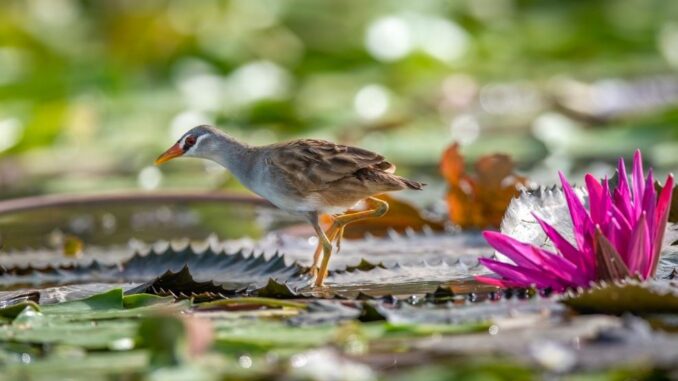
NINH BINH – Coming to Van Long Wetland Nature Reserve, visitors will encounter ginseng birds, water pheasants to rare white-breasted langurs.

Mr. Nguyen Manh Hiep works at the General Department of Forestry, Ministry of Agriculture and Rural Development, is an avid photographer of birds and wildlife in Vietnam. Combining the work, Mr. Hiep has a lot of time to explore and photograph birds and animals in Van Long lagoon. This is a wetland nature reserve located in Gia Vien district, about 17 km from Ninh Binh city and about 80 km from Hanoi.
With an area of over 3,000 hectares, Van Long is the largest wetland nature reserve in the Northern Delta. Highlights here are majestic limestone massifs, cave systems surrounded by wetlands, shallow lakes, rich vegetation and waterfowl.

The bird fauna in Van Long is rich, with 102 species recorded to date, including native waterfowl and migratory birds.
Van Long lagoon is home to many species of storks, such as white storks, large storks, small storks, fly storks, storks and snails (Anastomus oscitans, photo). Snail storks belong to the family of cranes, called storks because their favorite food is snails in marshy fields and rice fields.

The moldy duck (Anas acuta), a migratory bird, usually winters to feed in flooded habitats in the North and Central Plains, including Van Long lagoon.

Ginseng (Fulica atra), a migratory bird, has black plumage, white bill, and forehead. The interesting thing about this species is “flying on the water to gain momentum” before taking off to fly. Currently, ginseng is no longer common in distribution areas in northern Vietnam.

White-browed waterfowl (Rallina eurizonoides) feeding on a water lily pond. This is a small waterfowl with long legs and toes, easily distinguished from other waterfowl by the white markings above and below the eyes.

Water pheasant (Hydrophasianus chirurgus), an infrequent settler, is one of the most impressive birds photographed by the author in Van Long. According to Mr. Hiep, during the breeding season, this bird is easy to recognize due to its long tail feathers, and when flying, the wings are almost white.

The stork (Lxobrychus flavicollis) catches the fish and flies to the sky. The heron is a member of the heron family, with a slightly longer neck and long yellow beak, and eats fish, insects and amphibians.

A flock of spoonbills (Anas clypeata) flying over Van Long lagoon. This is a large, about 50 cm migratory bird in the duck family, with a dark spoon-shaped bill.

The flock of crescent ducks (Anas falcata), of which the recognizable male has a large glossy blackhead, is a migratory species, uncommon in marshes.
“Accessing and recording birds in general in Vietnam is not easy, birds are often caught by traps, so they are shy. Therefore, in order to get beautiful pictures of birds, in addition to shooting equipment, it is necessary to understand the behavior of birds and persevere when pursuing your passion, “said Mr. Hiep.

Van Long lagoon is not only an impressive eco-tourism destination, where visitors can observe birds and animals, but also a natural habitat of more than 200 individuals of langurs (also known as langurs). white, Trachypithecus delacouri), is a rare and endemic species listed in the Red Book of Vietnam and the world and is prioritized for protection.

Mr. Hiep said that it is called the white rump langur because the butt area has white hair extending to the base of the tail and thighs. Van Long is an easy place to observe with the naked eye the langurs in the natural environment in Vietnam.
| From May to July every year, Van Long’s water surface glows with a pink color of the blooming lotus season, which is the time when tourists visit the bay while watching lotuses and birds. However, from November to April next year (dry season), the new lagoon is filled with the white color of flocks of birds flying home, creating a very poetic scene. Visitors need to buy scenic tickets 20,000 VND / person and ferry tickets 60,000 VND / boat (carry 2 people). Taking a boat in Van Long, visitors can also discover more unique rocks such as Meo Rao mountain, Mam Xoi, Hom Sach, Da Ban, Nghien, Co Tien … and the caves of Fish, Ball, Turtle, Lemon…However, at present, due to Covid-19, all types of businesses and services, including tourist areas and attractions (such as Van Long lagoon), relics in Ninh Binh province are only allowed to welcome and serve tourists. provincial tourist service. |
Follow vnexpress/ Photo: Nguyen Manh Hiep
